| Question ID 13675 |
You are the administrator for three Azure subscriptions named Dev, Test, and Prod.
Your Azure Power Shell profile is configured with the Dev subscription as the default.
You need to create a new virtual machine in the Test subscription by using the least
administrative effort.
Which Power Shell command should you use?

|
| Option A |
Option A
|
| Option B |
Option B
|
| Option C |
Option C
|
| Option D |
Option D
|
| Correct Answer |
A |
Description Explanation: Example: Set the current subscription This command makes Testthe current subscription. Windows PowerShell C:\PS> Select-AzureSubscription -SubscriptionName Test -Current References:
| Question ID 13676 |
You administer an Azure Storage account with a blob container. You enable Storage
account logging for read, write and delete requests.
You need to reduce the costs associated with storing the logs.
What should you do?
|
| Option A |
Execute Delete Blob requests over https.
|
| Option B |
Create an export job for your container.
|
| Option C |
Set up a retention policy.
|
| Option D |
Execute Delete Blob requests over http.
|
| Correct Answer |
C |
Description Explanation: To ease the management of your logs, we have provided the functionality of retention policy which will automatically cleanup old logs without you being charged for the cleanup. It is recommended that you set a retention policy for logs such that your analytics data will be within the 20TB limit allowed for analytics data (logs and metrics combined). References:
| Question ID 13677 |
You manage a cloud service that has a web role named fabWeb. You create a virtual
network named fabVNet that has two subnets defined as Web and Apps.
You need to be able to deploy fabWeb into the Web subnet.
What should you do?
|
| Option A |
Modify the service definition (csdef) for the cloud service.
|
| Option B |
Run the Set-AzureSubnet PowerShell cmdlet.
|
| Option C |
Run the Set-AzureVNetConfig PowerShell cmdlet.
|
| Option D |
Modify the network configuration file.
|
| Option E |
Modify the service configuration (cscfg) for the fabWeb web role.
|
| Correct Answer |
A |
Description Explanation: Azure Service Definition Schema (.csdef File) The service definition file defines the service model for an application. The file contains the definitions for the roles that are available to a cloud service, specifies the service endpoints, and establishes configuration settings for the service.
| Question ID 13678 |
For development purposes, you deploy several virtual machines in an Azure subscription.
Developers report that the virtual machines fail to access each other.
You export the virtual network configuration for the subscription as shown in the following
output.
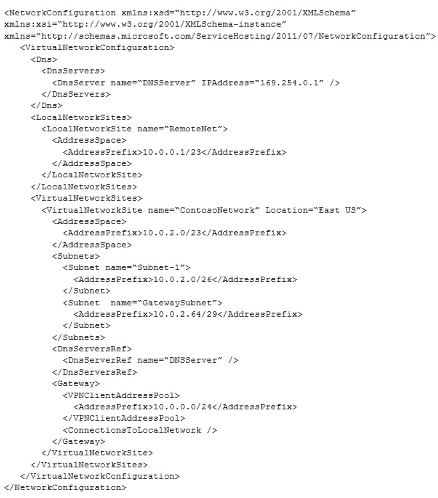
You need to modify the network configuration to resolve the connection issue.
What should you modify?
|
| Option A |
the IP address range of Subnet-1
|
| Option B |
the IP address range of the gateway subnet. the IP address of the DNS server
|
| Option C |
the site of the virtual network
|
| Correct Answer |
C |
Description
| Question ID 13679 |
You administer an Azure Storage account named contosostorage. The account has a blob
container to store image files.
A user reports being unable to access an image file.
You need to ensure that anonymous users can successfully read image files from the
container.
Which log entry should you use to verify access?
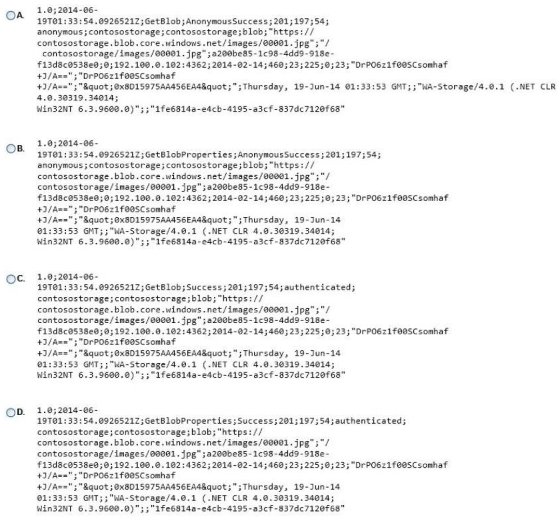
|
| Option A |
Option A
|
| Option B |
Option B
|
| Option C |
Option C
|
| Option D |
Option D
|
| Correct Answer |
A |
Description Explanation: Check for GetBlob and for AnonymousSuccess. Example: Get Blob AnonymousSuccess: 1.0;2011-07- 28T18:52:40.9241789Z;GetBlob;AnonymousSuccess;200;18;10;anonymous;;sally;blob;"htt p:// sally.blob.core.windows.net/thumbnails/lake.jpg?timeout=30000";"/sally/thumbnails/lake.jpg ";a84aa705-8a85-48c5-b064-b43bd22979c3;0;123.100.2.10;2009-09- 19;252;0;265;100;0;;;"0x8CE1B6EA95033D5";Thursday, 28-Jul-11 18:52:40 GMT;;;;"7/28/2011 6:52:40 PM ba98eb12-700b-4d53-9230-33a3330571fc" Incorrect: Not C: Check for AnonymousSuccess not Access. Not B, not D: Check for GetBlob not GetBlobProperties References:
Update Date and Time 2017-10-20 11:10:15
| Question ID 13680 |
You manage an Azure virtual network that hosts 15 virtual machines (VMs) on a single
subnet, which is used for testing a line of business (LOB) application. The application is
deployed to a VM named TestWebServiceVM.
You need to ensure that TestWebServiceVM always starts by using the same IP address.
You need to achieve this goal by using the least amount of administrative effort.
What should you do?
|
| Option A |
Use the Management Portal to configure TestWebServiceVM.
|
| Option B |
Use RDP to configure TestWebServiceVM.
|
| Option C |
Run the Set-AzureStaticVNetIP PowerShell cmdlet.
|
| Option D |
Run the Get-AzureReservedIP PowerShell cmdlet.
|
| Correct Answer |
C |
Description Explanation: Specify a static internal IP for a previously created VM If you want to set a static IP address for a VM that you previously created, you can do so by using the following cmdlets. If you already set an IP address for the VM and you want to change it to a different IP address, youll need to remove the existing static IP address before running these cmdlets. See the instructions below to remove a static IP. For this procedure, youll use the Update-AzureVM cmdlet. The Update-AzureVM cmdlet restarts the VM as part of the update process. The DIP that you specify will be assigned after the VM restarts. In this example, we set the IP address for VM2, which is located in cloud service StaticDemo. Get-AzureVM -ServiceName StaticDemo -Name VM2 | Set-AzureStaticVNetIP -IPAddress 192.168.4.7 | Update-AzureVM References:
Update Date and Time 2017-10-20 11:11:04
| Question ID 13681 |
You have an Azure subscription.
In Azure, you create two virtual machines named VM1 and VM2. Both virtual machines are
instances in a cloud service named Cloud1.
You need to ensure that the virtual machines only replicate within the data center in which
they were created.
Which settings should you modify?
|
| Option A |
virtual machine
|
| Option B |
storage account
|
| Option C |
cloud services
|
| Option D |
Azure subscription
|
| Correct Answer |
B |
Description
Update Date and Time 2017-10-20 11:11:50
| Question ID 13682 |
You manage an Azure subscription with virtual machines (VMs) that are running in
Standard mode.
You need to reduce the storage costs associated with the VMs.
What should you do?
|
| Option A |
Locate and remove orphaned disks.
|
| Option B |
Add the VMs to an affinity group.
|
| Option C |
Change VMs to the Basic tier.
|
| Option D |
Delete the VHD container.
|
| Correct Answer |
C |
Description Explanation: Standard offers 50 GB of storage space, while Basic only gives 10 GB but it will save costs. References:
| Question ID 13683 |
Your development team has created a new solution that is deployed in a virtual network
named fabDevVNet.
Your testing team wants to begin testing the solution in a second Azure subscription.
You need to create a virtual network named fabTestVNet that is identical to fabDevVNet.
You want to achieve this goal by using the least amount of administrative effort.
Which three steps should you perform in sequence? To answer, move the appropriate
actions from the list of actions to the answer area and arrange them in the correct order.
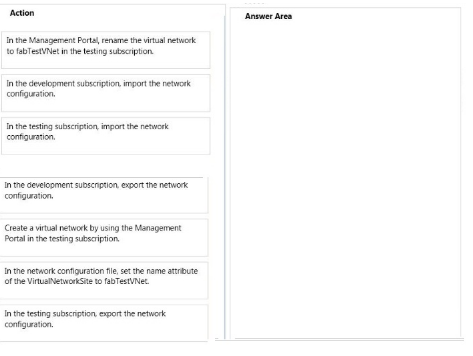
|
| Option A |
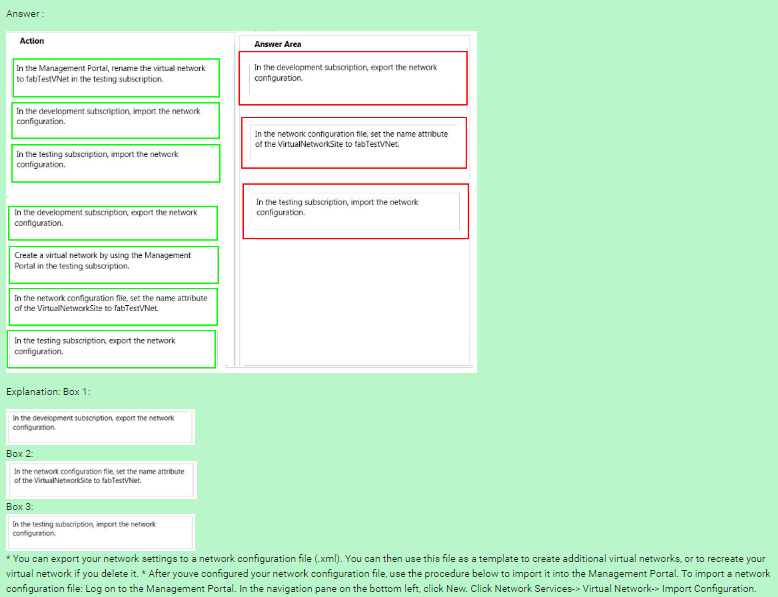
|
| Correct Answer |
A |
Description
| Question ID 13684 |
You administer an Azure Virtual Machine (VM) named server1. The VM is in a cloud
service named ContosoService1.
You discover that the VM is experiencing storage issues due to increased application
logging on the server.
You need to create a new 256-GB disk and attach it to the server.
Which Power Shell cmdlets should you use? To answer, drag the appropriate cmdlet to the
correct location in the Power Shell command. Each cmdlet may be used once, more than
once, or not at all. You may need to drag the split bar between panes or scroll to view
content.
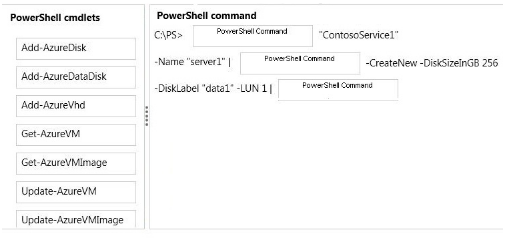
|
| Option A |
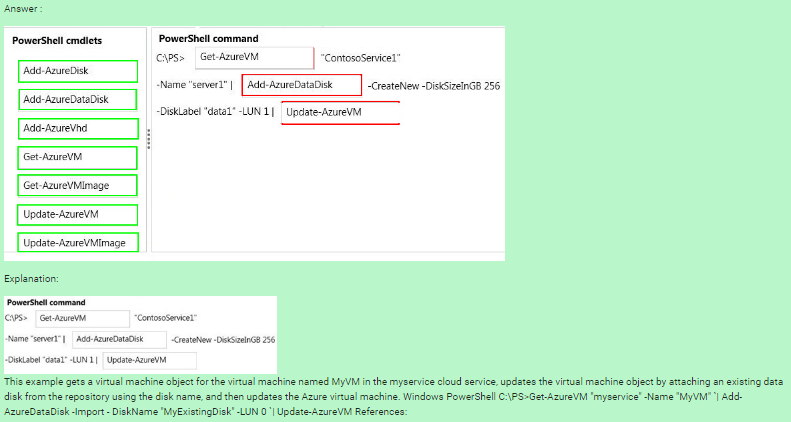
|
| Correct Answer |
A |
Description
| Question ID 13685 |
You manage an application hosted on cloud services. The development team creates a
new version of the application. The updated application has been packaged and stored in
an Azure Storage account.
You have the following requirements:
Which four steps should you perform in sequence? To answer, move the appropriate
actions from the list of actions to the answer area and arrange them in the correct order.

|
| Option A |

|
| Correct Answer |
A |
Description
Update Date and Time 2017-10-20 11:19:09
| Question ID 13686 |
You create a Push Notification service by using an Azure Notification Hub.
You need to monitor the Notification Hub programmatically.
Which three actions should you perform in sequence? To answer, move the appropriate
actions from the list of actions to the answer area and arrange them in the correct order.
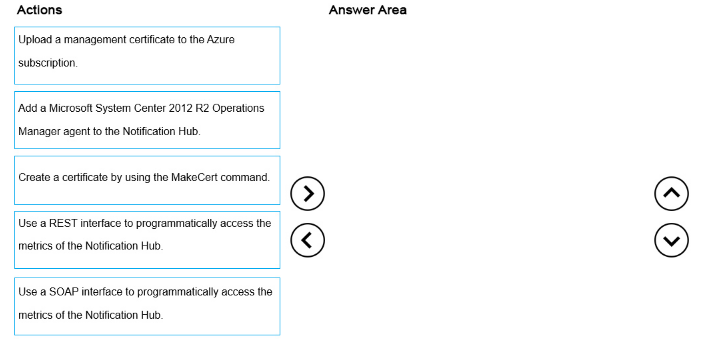
|
| Option A |
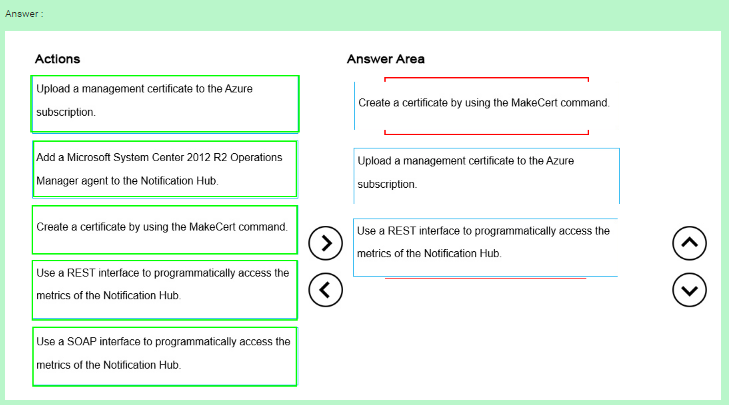
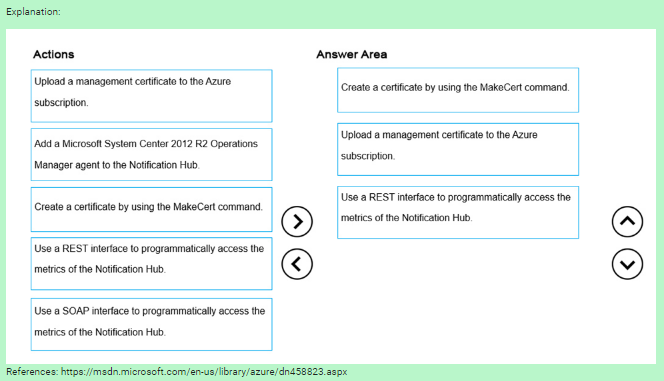
|
| Correct Answer |
A |
Description
Update Date and Time 2017-10-20 11:22:12
| Question ID 13687 |
You have an Azure SQL Database named Contosodb. Contosodb is running in the
Standard/S2 tier and has a service level objective of 99 percent.
You review the service tiers in Microsoft Azure SQL Database as well as the results of
running performance queries for the usage of the database for the past week as shown in
the exhibits. (Click the Exhibits button.)
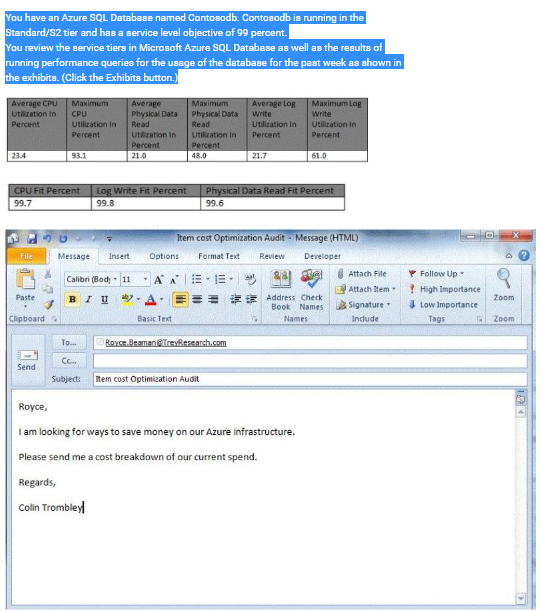
For each of the following statements, select Yes if the statement is true. Otherwise, select
No.
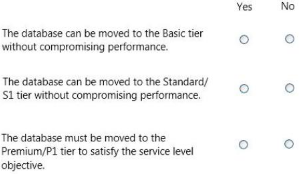
|
| Option A |
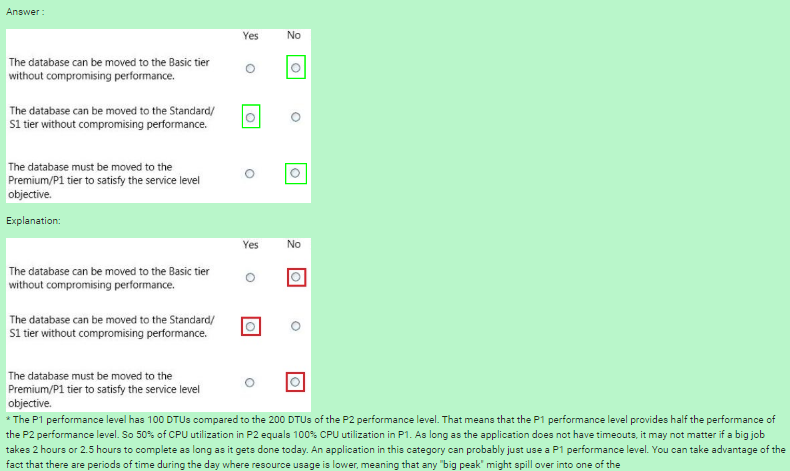
|
| Correct Answer |
A |
Description
Update Date and Time 2017-10-20 11:59:01
| Question ID 13688 |
You have an Azure SQL Database named Contosodb. Contosodb is running in the
Standard/S2 tier and has a service level objective of 99 percent.
You review the service tiers in Microsoft Azure SQL Database as well as the results of
running performance queries for the usage of the database for the past week as shown in
the exhibits. (Click the Exhibits button.)
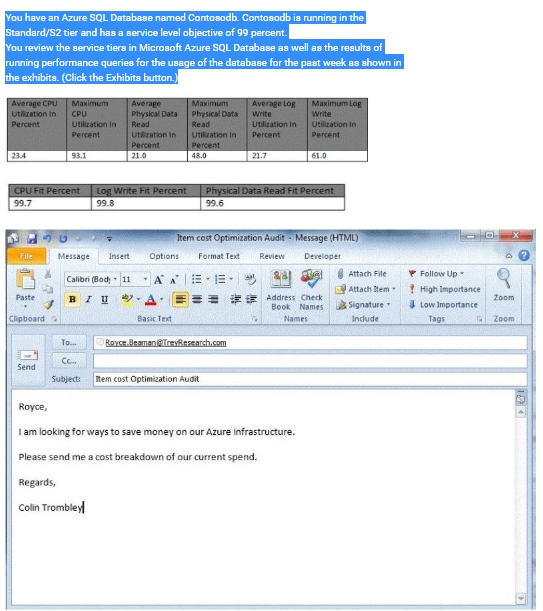
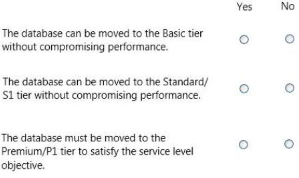
|
| Option A |
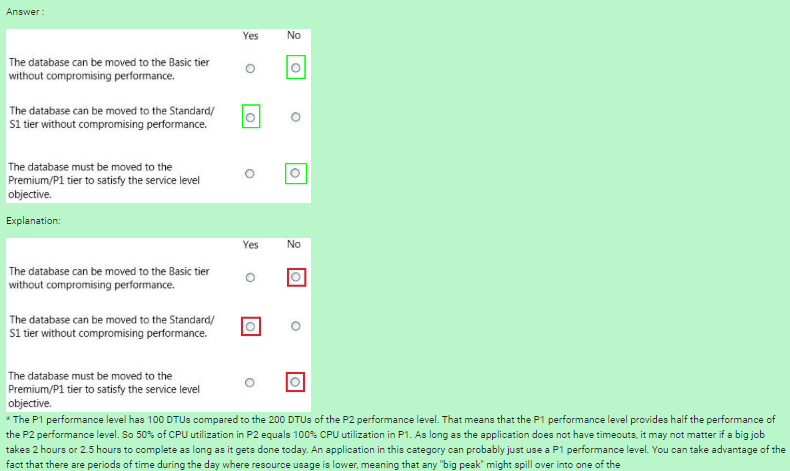
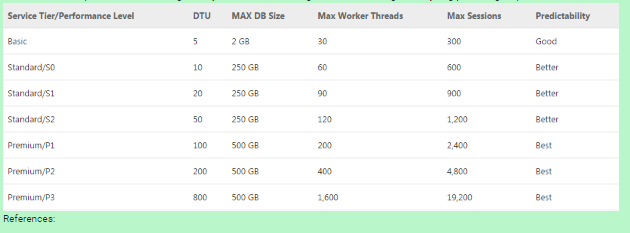
|
| Correct Answer |
A |
Description
Update Date and Time 2017-10-20 12:03:15
| Question ID 13689 |
You manage a software-as-a-service application named SaasApp1 that provides user
management features in a multi-directory environment.
You plan to offer SaasApp1 to other organizations that use Azure Active Directory.
You need to ensure that SaasApp1 can access directory objects.
What should you do?
|
| Option A |
Configure the Federation Metadata URL
|
| Option B |
Register SaasApp1 as a native client application.
|
| Option C |
Register SaasApp1 as a web application.
|
| Option D |
Configure the Graph API.
|
| Correct Answer |
D |
Description Explanation: The Azure Active Directory Graph API provides programmatic access to Azure AD through REST API endpoints. Applications can use the Graph API to perform create, read, update, and delete (CRUD) operations on directory data and objects. For example, the Graph API supports the following common operations for a user object: / Create a new user in a directory / Get a users detailed properties, such as their groups / Update a users properties, such as their location and phone number, or change their password / Check a users group membership for role-based access / Disable a users account or delete it entirely References:
Update Date and Time 2017-10-20 12:04:06
| Question ID 13690 |
You manage a large datacenter that has limited physical space.
You plan to extend your datacenter to Azure.
You need to create a connection that supports a multiprotocol label switching (MPLS)
virtual private network.
Which connection type should you use?
|
| Option A |
Site-to-site
|
| Option B |
VNet-VNet
|
| Option C |
ExpressRoute.
|
| Option D |
Site-to-peer
|
| Correct Answer |
C |
Description Explanation: ExpressRoute allows you to securely add compute and storage capacity to your existing datacenter. With high throughput and fast latencies, Azure will feel like a natural extension to your datacenter so you enjoy the scale and economics of the public cloud without having to compromise on network performance. References:
Update Date and Time 2017-10-20 12:04:58